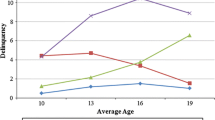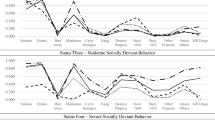Abstract
This article evaluates the utility of social development model constructs toassess the correlates of onset, escalation, deescalation, and desistance ofdelinquent behavior, from age 12 to age 15, using a dynamic classificationapproach. Dynamic classification places individuals into categories basedon changes in levels of delinquent behavior over time. These analyses assessthe extent to which specific constructs are associated with changes in thedelinquency status of individuals. Constructs of the social developmentmodel (SDM), including opportunities for conventional involvement, skillsfor conventional involvement, rewards for conventional involvement,proactive family management, bonding to conventional society, opportunitiesfor antisocial involvement, antisocial interactions, perceived rewards forantisocial involvement, and norms against drug use, were significantlyassociated with change in delinquent behavior over time. Many of theconstructs were particularly salient in distinguishing between youths whoremained involved in delinquency and youths who deescalated or desisted fromdelinquent behavior during this period. Implications for preventiveinterventions and criminological theory are discussed.
Similar content being viewed by others
REFERENCES
Achenbach, T. M., and Edelbrock, C. (1983). Manual for the Child Behavior Checklist and Revised Child Behavior Profile, University of Vermont Press, Burlington.
Akers, R. L. (1977). Deviant Behavior: A Social Learning Approach, 2nd ed., Wadsworth Press, Belmont, CA.
Akers, R. L., Krohn, M. D., Lanza-Kaduce, L., and Radosevich, M. (1979). Social learning and deviant behavior: A specific test of a general theory. Am. Sociol. Rev. 44: 636–655.
Bandura, A. (1973). Aggression: A Social Learning Analysis, Prentice-Hall, Englewood Cliffs, NJ.
Bandura, A. (1977). Social Learning Theory, Prentice-Hall, Englewood Cliffs, NJ.
Barnett, A., Blumstein, A., and Farrington, D. P. (1987). Probabilistic models of youthful criminal careers. Criminology25: 83–107.
Blumstein, A., Cohen, J., and Farrington, D. P. (1988). Criminal career research: Its value for criminology. Criminology26: 1–35.
Bollen, K. A., and Lennox, R. (1991). Conventional wisdom on measurement: A structural equation perspective. Psychol. Bull. 110(2): 305–314.
Briar, S., and Piliavin, I. (1965). Delinquency, situational inducements and commitment to conformity. Soc. Problems13: 25–45.
Burgess, R. L., and Akers, R. L. (1966). A differential association-reinforcement theory of criminal behavior. Soc. Problems4: 128–147.
Catalano, R. F., and Hawkins, J. D. (1996). The social development model: A theory of antisocial behavior. In Hawkins, J. D. (ed.), Delinquency and Crime: Current Theories, Cambridge University Press, New York.
Cohen, J. (1988). Statistical Power Analysis for the Behavioral Sciences, 2nd ed., Lawrence Erlbaum, Hillsdale, NJ.
Conger, R. D. (1976). Social control and social learning models of delinquent behavior: A synthesis. Criminology14: 17–40.
Conger, R. D. (1980). Juvenile delinquency: Behavior restraint for behavior facilitation. In Hirschi, T., and Gottfredson, M. (eds.), Understanding Crime, Sage, Beverly Hills, CA.
Cressey, D. R. (1953). Other People's Money, Free Press, New York.
Dunford, F. W., and Elliott, D. (1984). Identifying career offenders using self-reported data. J. Res. Crime Delinq. 21: 57–86.
Elliott, D. S., Huizinga, D., and Ageton, S. S. (1985). Explaining Delinquency and Drug Use, Sage, Beverly Hills, CA.
Elliott, D. S., Huizinga, D., and Menard, S. (1989). Multiple Problem Youth: Delinquency, Substance Use and Mental Health Problems, Springer-Verlag, New York.
Farrington, D. P. (1983). Offending from 10 to 25 years of age. In Van Dusen, K. T., and Mednick, S. A. (eds.), Prospective Studies of Crime and Delinquency, Kluwer-Nijhoff, Boston, pp. 17–37.
Farrington, D. P. (1986). Stepping stones to adult criminal careers. In Olweus, D., Block, J., and Yarrow, M. R. (eds.), Development of Antisocial and Prosocial Behavior, Academic Press, New York.
Farrington, D. P. (1987). Early precursors of frequent offending. In Wilson, J. Q., and Loury, G. C. (eds.), From Children to Citizens: Families, Schools and Delinquency Prevention, Springer-Verlag, New York, pp. 27–50.
Farrington, D. P., and Hawkins, J. D. (1991). Predicting participation, early onset, and later persistence in officially recorded offending. Crim. Behav. Ment. Health1: 1–33.
Feldman, R. A., Caplinger, T. E., and Wodarski, J. S. (1983). The St. Louis Conundrum: The Effective Treatment of Antisocial Youths, Prentice-Hall, Englewood Cliffs, NJ.
Gottfredson, M. R., and Hirschi, T. (1990). A General Theory of Crime, Stanford University Press, Stanford, CA.
Hamparian, D., Schuster, R., Dinitz, S., and Conrad, J. (1978). The Violent Few: A Study of Dangerous Juvenile Ofenders, Lexington Books, Lexington, MA.
Hawkins, J. D., and Weis, J. G. (1985). The social development model: An integrated approach to delinquency prevention. J. Primary Prev. 6: 73–97.
Hawkins, J. D., Catalano, R. F., Morrison, D. M., O'Donnell, J., Abbott, R. D., and Day, L. E. (1992). The Seattle Social Development Project: Effects of the first four years on protective factors and problem behaviors. In McCord, J., and Tremblay, R. (eds.), The Prevention of Antisocial Behavior in Children, Guilford, New York, pp. 139–161.
Hindelang, M. J. (1973). Causes of delinquency: A partial replication and extension. Soc. Problems20: 471–487.
Hirschi, T. (1969). Causes of Delinquency, University of California Press, Berkeley.
Huizinga, D., Esbensen, F., and Weiher, A. W. (1991). Are there multiple paths to delinquency? J. Crim. Law Criminol. 82: 83–118.
Huizinga, D., Loeber, R., and Thornberry, T. (1993). Urban Delinquency and Substance Abuse, Office of Juvenile Justice and Delinquency Prevention, Washington, DC.
Kornhauser, R. R. (1978). Social Sources of Delinquency: An Appraisal of Analytic Models, University of Chicago Press, Chicago.
Krohn, M. D., Lance-Kaduce, L., Radosevich, M., and Akers, R. L. (1980). Cessation of alcohol and drug use among adolescents: A social learning model. Paper presented at the Society of Social Problems Annual Meeting, New York.
LeBlanc, M., and Fre´chette, M. (1989). Male Offending from Latency to Adulthood, Springer-Verlag, New York.
Loeber, R., and LeBlanc, M. (1990). Toward a developmental criminology. In Tonry, M., and Morris, N. (eds.), Crime and Justice: An Annual Review of Research, Vol. 12,University of Chicago Press, Chicago.
Loeber, R., Stouthamer-Loeber, M. S., von Kammen, W., and Farrington, D. P. (1991). Initiation, escalation, and desistance in juvenile offending and their correlates. J. Crim. Law Criminol. 82: 36–82.
Matsueda, R. L. (1982). Testing control theory and differential association: A causal modeling approach. Am. Sociol. Rev. 47: 489–504.
Matsueda, R. L. (1988). The current state of differential association theory. Crime Delinq. 34: 277–306.
Matza, D. (1969). Becoming Deviant, Prentice-Hall, Englewood Cliffs, NJ.
Moffitt, T. E. (1993). Adolescent-limited and life-course persistent antisocial behavior: A developmental taxonomy. Psychol. Rev. 100: 574–701.
Nagin, D. S., and Land, K. C. (1993). Age, criminal careers, and population heterogeneity: Specification and estimation of a nonparametric, mixed Poisson model. Criminology31: 327–362.
Nagin, D. S., Farrington, D. P., and Moffitt, T. E. (1995). Life-course trajectories of different types of offenders. Criminology33: 111–139.
Office of Juvenile Justice and Delinquency Prevention (1993). Comprehensive Strategy for Serious, Violent, and Chronic Juvenile Offenders(OJJDP Program Summary), Author, Washington, DC.
Sampson, R. J., and Laub, J. H. (1993). Crime in the Making: Pathways and Turning Points Through the Life Course, Harvard University Press, Cambridge, MA.
Shannon, L. W. (1978). A longitudinal study of delinquency and crime. In Wellford, S. (ed.), Quantitative Studies in Crime, Sage, Beverly Hills, CA.
Shannon, L. W. (1988). Criminal Career Continuity: Its Social Context, Human Sciences Press, New York.
Shannon, L. W. (1991). Changing Patterns in Delinquency and Crime: A Longitudinal Study in Racine, Westview Press, Boulder, CO.
Snyder, H. (1988). Court Careers of Juvenile Offenders, Office of Juvenile Justice and Delinquency Prevention, Washington, DC.
Sutherland, E. H. (1973). Development of the theory [Private paper published posthumously]. In Schuessler, K. (ed.), Edwin Sutherland on Analyzing Crime, University of Chicago Press, Chicago.
Thornberry, T. P. (1996). Empirical support for interactional theory: A review of the literature. In Hawkins, J. D. (ed.), Delinquency and Crime: Current Theories, Cambridge University Press, New York.
Tracy, P., Wolfgang, M., and Figlio, R. (1985). Delinquency in Two Birth Cohorts,National Institute of Juvenile Justice and Delinquency Prevention, Washington, DC.
West, D. J., and Farrington, D. P. (1977). The Delinquent Way of Life, Heinemann, London.
Williams, J. H., Ayers, C. D., Abbott, R. D., and Hawkins, J. D. (1998). Adolescent delinquency and substance use: A logit analysis of race and gender differences in initiation rates(submitted for publication).
Wilson, J. Q., and Herrnstein, R. J. (1985). Crime and Human Nature, Simon and Schuster, New York.
Wolfgang, M. E. (1983). Delinquency in two birth cohorts. Am. Behav. Sci. 27: 75–86.
Wolfgang, M. E., Figlio, R. F., and Sellin, T. (1972). Delinquency in a Birth Cohort, University of Chicago Press, Chicago.
Wolfgang, M. E., Thornberry, T. P., and Figlio, R. M. (1987). From Boy to Man-From Delinquency to Crime: Follow-up to the Philadelphia Birth Cohort of 1945, University of Chicago Press, Chicago.
Author information
Authors and Affiliations
Rights and permissions
About this article
Cite this article
Ayres, C.D., Williams, J.H., Hawkins, J.D. et al. Assessing Correlates of Onset, Escalation, Deescalation, and Desistance of Delinquent Behavior. Journal of Quantitative Criminology 15, 277–306 (1999). https://doi.org/10.1023/A:1007576431270
Issue Date:
DOI: https://doi.org/10.1023/A:1007576431270




